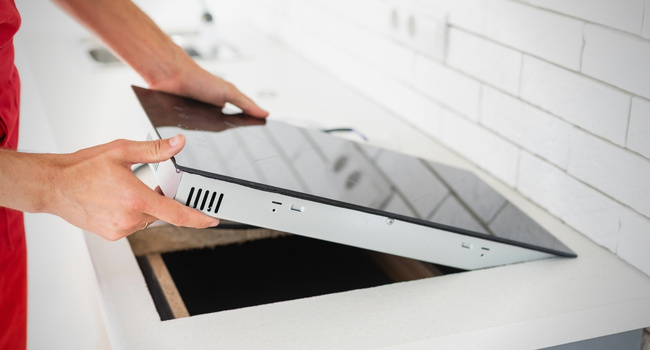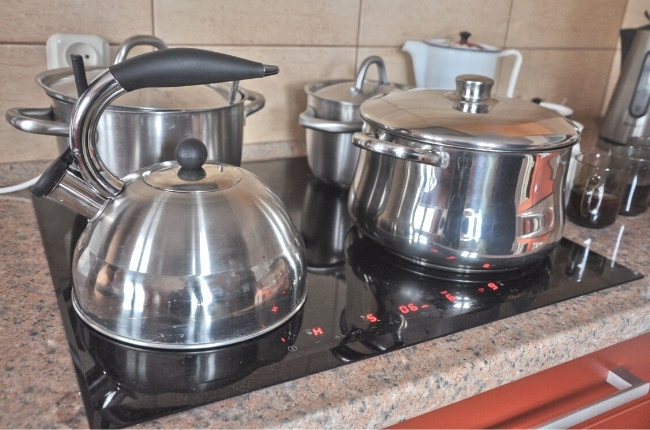It’s the holiday season!
Everyone knows that holidays always bring everyone home. And what’s a better flex than a new set of induction-ready pans to go with your induction cooktop?
So it would be disconcerting if you suddenly discovered that the induction cooker cannot detect the pan. Is it your cooker? Is it the pan? Worse, is it both?
Let’s explore why your pan doesn’t work with your induction cooktop and how you may solve that puzzle without ditching them altogether.
Why won’t my induction pans work?
Owning an induction cooker is like stock trading. Everyone has an idea what it is but only a tiny percentage of people actually invest in it, partly because they are full of apprehension despite the tempting prospects.
Sure, something “new” can be scary. And since you are here with an induction cooker/pan problem, that can also lead to real frustrations and regrets.
Take a breath. It’s not too late!
The first step to knowing if you can fix your recent problem is understanding how your induction works.
The science of induction starts when you plug in and turn on your induction cooker.
An alternating current runs on a metal coil found under the ceramic glass top. The current then produces a fluctuating magnetic field.
When you place an induction-compatible pan on your cooktop, the magnetic field affects the atoms of your pans. They start vibrating, and the energy released from that is in the form of heat.
It may be weird to feel a pan heating itself up without seeing any flame, but that’s the beauty of induction!
Not only does it save you from a possible fire hazard, but it’s also more energy and time efficient, aesthetically pleasing, and easier to clean.
Since the science of induction is more complex than traditional direct heating, you must pay extra attention to the cooktop and the cookware you want to use with it.
It might be your cooktop.
An induction can have many features — from a single burner with varied temperature and power settings to individual timers and even having Alexa connected to it! It’s a new technology with a learning curve that you’d want to devote time to.

One important feature centers around advanced safety, e.g., auto shutdowns, residual heat indicators, and lock systems. The last one ensures that you or your children do not accidentally turn on the cooktop by touching the control panel.
If the lock button’s indicator light is on, that may cause your pans to be undetectable — no matter how reliable your pan is!
So to unlock your cooker, press the lock button for five seconds. The cooktop may indicate a successful unlocking via an audible sound or the indicator light disappearing.
How about if every indicator light is off in the first place?
Well, then, you may have a power problem.
An induction cooker will not detect your pan if you don’t supply the needed power.
There’s a specific power requirement for every induction out there.
A single burner with 1200-1800 W typically needs a separate circuit supporting 15 amps. Induction ranges with multiple burners and different designs have different power requirements. Check the manual first before you use it.
If you had your unit professionally installed, that’s better. To supply power to your cooktop, check and fix the wirings connected to your circuit, i.e.whether they are twisted or damaged already.
You may also want to inspect the heating element itself.
First, shut off the power at the circuit and disconnect the wires at the junction box. Depending on your induction, you can try to unscrew the cooktop and lift the glass surface. If able, check for faulty wirings on the heating element and/or blown fuses under the copper coil.
If the copper coil is troublesome, replacing it is a must.
A faulty burner isn’t a simple trouble to deal with. However, it’s not impossible to DIY, either.
An important disclaimer: Maintenance and repair is a job better left to the professionals.

Assuming you have confidence in your ability, you can replace the copper coil.
After shutting the circuit and wirings, unscrew the cooktop to lift off the glass surface. In the support rail, you will see a wire harness and spring clips connected to the coil. Disconnect the wire harnesses and depress the spring clips.
You can mount the replacement copper coil and use the old spring clips (if not provided) and wire harnesses to attach to your cooktop.
If you have checked the power supply, disengaged lock features, or possibly faulty burners, and everything is okay, try this restart trick.
Turn off the circuit breaker and shut down the power for about 10 seconds. After which, turn it all back on and plug in your cooktop. This performs a hard reset and puts the cooktop in its default mode.
Severely scratched or damaged glass ceramic tops may also cause the malfunction. If you want to avoid that, use ceramic-friendly cleaning products and always wait for your cooktop to cool down before cleaning.
These few simple steps may solve your pan problems if they are cooktop-related. But how about if they aren’t?
Or… it might be your cookware.
Induction-compatible cookware must be ferromagnetic, aka it must contain enough iron to react with the magnetic field produced by your induction cooktop. Otherwise, you’d have difficulty letting your cooktop detect the pan.
Cast iron, enameled or raw, is a perfect example. Magnetic stainless steel and multi-clad cookware with a stainless steel exterior also work.
Pro tip: High-quality brands offer the most reliable induction cookware, albeit expensive. Also, look for a thicker base since this can indicate more ferromagnetic material.

But if you already did your homework and looked for induction-compatible pots and pans, congrats! You are a step ahead.
If you encounter a problem even when you have secured the material composition of your pans, the following reasons may shed light on your dilemma.
So, why do some pans not work on induction?
The size and position of the pan matter in its detection.
Scenario No. 1: The pan is bigger than the burner.
A typical induction cooker has circles indicating the position of the heating element. When cooking, you’d want to center your pan on this circle to maximize heating efficiency.
If you put a bigger pan on a smaller heating element, it will take time for your pan to heat. It’s not impossible, but you will waste energy by doing so. Goodbye efficiency!
Scenario no. 2: The pan is smaller than the burner.
If your pan is too small, your induction may not activate.
The magnets do not register it; even if they do, they will likely produce less heating power. It’s also inefficient!
The energy that should’ve been on the pan is now gone in the atmosphere due to the exposed burner surface.
The golden rule to the size and position dilemma is to buy a pan with dimensions that fit your burner zones.
The second reason lies in surface contact.
What type of object will have maximized surface area? Yep, a flat object. Not a round one!
That’s why it’s also necessary to check for the shape and smoothness of the pan’s base.
You want it to be flat and smooth so every bit of it comes in contact with the heating element, increasing efficiency. Look for rough edges on the metal or burrs.
Thin and lightweight metals can deform easily under high temperatures, so be on the lookout. There is defective and low-quality cookware that may be cheap but is often the cause of your induction cookware not working.
How do I know if my pan works with induction?
Let’s introduce you to the most effective and straightforward test: the magnet test.
You can perform this test if you are unsure how suitable your cookware is for your induction.
Stick a magnet at the bottom of the pan. If it sticks well, you got yourself a perfect fit for your induction. If it slides off easily, it might/might not work because it doesn’t have enough magnetic strength.
Again, anything with enough iron should be your go-to.
That said, unless it has “iron” in its name, you should perform the magnet test. For example, not all stainless steel works well with induction. You have to look for the magnetic one!
When you go to the cookware aisle, check the bottom of the pan or pots you like.
An induction symbol has four loops that appear like a coiled wire. Some brands plainly spell “induction” right there.
What pans won’t work with induction?
Non-ferromagnetic pans will not work with induction.
Additionally, unless you got yours from a reputable brand, you could have bought defective cookware that’s thin and has weak magnetism— that, too, may be undetectable.
Pans made of aluminum, copper, ceramic, and glass will inherently not be induction-approved.
Moreover, if you have dimensionally unfit pans, your cooktop may not register your cookware or have difficulty heating it as efficiently.
An excellent pan is ferromagnetic, flat-bottomed, smooth, and has the correct dimensions. That is something you must remember!
How do I get my pans to work on an induction hob?
One of the blessings of the internet is the ability to share tips and tricks on common problems, e.g., how to make a pan work on induction.
Is your pan too small for an induction hob? Or is it not ferromagnetic in the least? Fear not! Below are lists of conventional and unconventional ways you can try.
- Use an interface disk to transfer heat to your non-ferromagnetic cookware. An interface disk is a round magnetic stainless steel plate with a handle. Place it on your cooktop, then put your pan on top of it, and as the plate heats itself through induction, the heat will transfer directly to the cookware.
- Use computer thermal paste to smoothen possible burrs and other metal roughness. The paper-thin layer of thermal paste you applied will eventually break down, so you should check on it occasionally.
- For small pans in a large burner zone, you can trick the magnetic sensor by placing coins or a piece of steel around the pan and inside the burner zone until the sensor detects it. Theoretically, the sensor detects this as cookware with a larger surface area.
Bear in mind that if you want to try any of those other than a high-quality interface disk, you risk deforming the metal, losing efficiency, and causing damage to both cookware and cooktop.
Why is my Tefal pan not working on induction?
Tefal is a popular brand best known for inexpensive yet good-quality cookware. If you are encountering a problem with your Tefal pans, try to check this list (as discussed above):
- Is the power supply on, and does it meet requirements?
- Are the heating elements in good condition?
- Is the lock mechanism turned off?
- Is your Tefal pan made of ferromagnetic material?
- Does your Tefal pan fit your burner zone?
If all seems well and your pans still do not work even with the solutions described above, maybe it’s time to look for additional Tefal sets and individual pieces like these:
- Tefal Ingenio pans and a five-piece set
- Tefal 5-piece Comfort Max
- Tefal Ingenio Expertise Non-stick
- Tefal Premium Non-stick
Since it’s relatively cheaper and comes in stylish sets, you’ll find shopping online a more enjoyable experience as well.
Unlike stock trading, it’s an investment that will ALWAYS go right for you if you choose to do your research first!
Invest wisely!

Leave a Reply